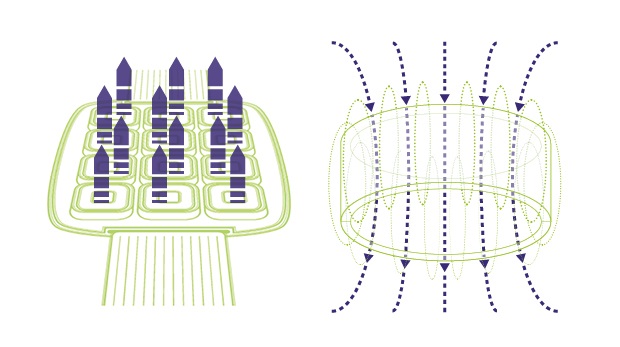Veterinary magnetotherapy is a non-invasive physical therapy that uses low-intensity, low-frequency pulsed magnetic fields (ELF, 1–100 Hz) to promote cell regeneration, reduce inflammation, and control pain. Widely studied in human medicine, it is also used in the veterinary field, both for pets and for sports horses, with specific protocols validated by numerous scientific studies (over 1,500 peer-reviewed publications).
Mechanism of action
Pulsed magnetic fields exert their effects through two main mechanisms:
- Magneto-electric effect: they induce ionic microcurrents that modulate cell permeability and intracellular concentrations of calcium (Ca2+), sodium (Na+), and potassium (K+), stimulating mitochondrial metabolism..
- Magneto-mechanical effect: they orient molecules and cellular structures, promoting biochemical reactions and regenerative processes.
These mechanisms allow increasing oxygenation and nutrients in tissues, improving nerve conduction and reducing muscle contractures and chronic pain.

Discover Qs Vet Magnetotherapy products
Biological effects of magnetotherapy
Veterinary magnetotherapy produces multiple therapeutic effects useful in clinical practice:
- Bio-stimulating effects: stimulates bone, muscle, cartilage, and nerve regeneration.
- Anti-inflammatory and anti-oedema effects: modulates biochemical markers, reduces local oedema and haemorrhages.
- Analgesic effects: inhibits nerve transmission of pain and reduces muscle tension.
- Pro-repair effects: promotes wound and ulcer healing, speeds up bone consolidation in fractures or pseudoarthrosis.
Specific actions on tissues
Osteoarticular level
- Stimulates bone matrix mineralisation and osteoblastic differentiation.
- Promotes fracture healing and protects articular cartilage (useful in osteoarthritis and arthritis).
Neuromuscular level
- Promotes nerve regeneration and myogenesis.
- Reduces chronic pain and muscle fatigue.
Vascular and tissue level
- Improves microcirculation and promotes angiogenesis.
- Supports the healing of wounds and skin ulcers.
Therapeutic indications
Veterinary magnetotherapy is used in numerous clinical conditions, including:
- Osteoarticular diseases: osteoarthritis, arthritis, osteoporosis
- Fractures and delayed bone consolidation
- Muscle lesions: strains, sprains, contusions
- Peripheral nerve lesions
- Chronic wounds and ulcers
- Post-traumatic oedema
Magnetotherapy for dogs and horses
Magnetotherapy for dogs
indicated for treating osteoarthritis, dysplasia, fractures, and chronic pain. It improves mobility and reduces the need for analgesic or anti-inflammatory drugs, with benefits for well-being and quality of life.
Magnetotherapy for horses
particularly used in sports to promote post-trauma recovery, accelerate muscle and joint healing, and prevent relapses in animals undergoing intense training.
Advantages of veterinary magnetotherapy
- Non-invasive and painless
- Well tolerated by animals
- Also acts on deep tissue
- Can be integrated with other therapies (pharmacological, physiotherapy, laser therapy)
- Also useful as home treatment, under veterinary guidance
Veterinary magnetotherapy today represents a versatile clinical tool, supported by solid scientific foundations, which allows veterinarians to integrate a natural, effective, and safe approach to managing pain, inflammation, and regenerative processes in dogs, cats, and horses.





